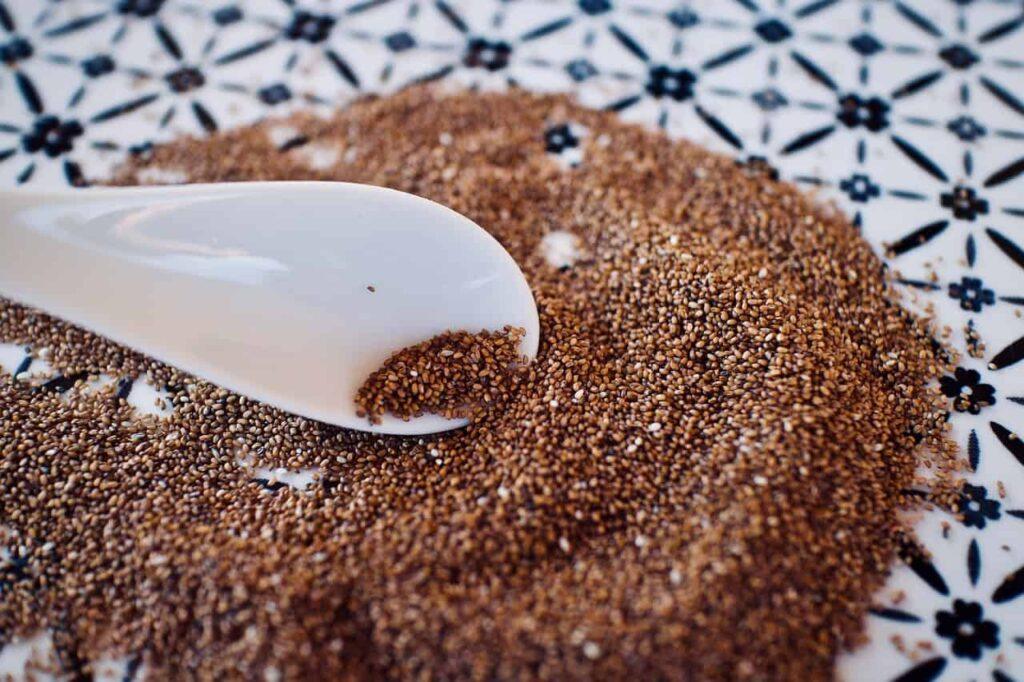The Best Bulgur Wheat Substitutes: Tasty Alternatives That Work {Plus Gluten-Free Options}
This post may contain affiliate links. Please see my disclosure policy for details.
When I first started experimenting with healthier grain options in my cooking, I came across bulgur wheat.
It’s a popular ingredient in Middle Eastern and Mediterranean dishes, and it’s known for its delicious nutty flavor and quick cooking time, which are all winners in my book! However, sometimes availability issues or dietary preferences may prompt us to look for some bulgur wheat substitutes.
One day, I, too, had to find an alternative to bulgur wheat, and that’s when I discovered there are actually numerous suitable replacements.
Whether you’re gluten-free or want to diversify your dishes by trying new grains, this exploration of bulgur wheat substitutes might be just the thing for you.
Throughout my culinary journey, I’ve found several grains that can mimic the texture and taste of bulgur wheat. As you read on, you’ll learn about my favorite options for making your dishes just as delicious and nutritious as they would be with bulgur wheat.

What Is Bulgur Wheat and What Does It Taste Like?
Bulgur wheat is a whole grain made from cracked wheat kernels, originating from the Middle East. It’s a popular ingredient in many dishes like tabbouleh and pilaf.
One of the reasons I love bulgur is because of its versatility and quick cooking time.
When it comes to flavor, bulgur has a subtle, nutty taste. The texture can vary from light and fluffy to chewy, depending on how it’s prepared.
It’s easy to incorporate into various recipes due to its mild taste, as it absorbs the flavors of other ingredients.
Some characteristics of bulgur wheat that I love is:
- Short cooking time: It usually takes around 10 to 15 minutes to cook.
- Nutritious: It’s a good source of fiber, vitamins, and minerals.
- Nutty flavor: The taste is mild and slightly nutty. YUM
- Adaptable: Can be used in different dishes like salads, stews, and side dishes.
In my cooking, I find that bulgur wheat pairs well with a variety of flavors and ingredients. Some common uses for bulgur include:
- Tabbouleh: A traditional Middle Eastern salad featuring herbs, tomatoes, and sometimes cucumber.
- Pilaf: A dish made by lightly browning rice or grains, like bulgur, and then cooking them in a seasoned broth.
- Stuffed vegetables: Many recipes call for bulgur as a filling for bell peppers or tomatoes.
- Breakfast porridge: Some people like to enjoy it as a warm breakfast cereal, sweetened with agave, honey or maple syrup.
Overall, I believe that bulgur wheat is a versatile and nutritious ingredient that can add a delightful nutty taste and texture to a wide range of dishes.
Wheat-based Substitutes for Bulgur Wheat
If you don’t have a sensitivity to wheat or gluten, then these options work great to swap our bulgur wheat! If you are sensitive or allergic, then keep scrolling down, and I have several wonderful gluten-free options for you!
Cracked Wheat
Cracked wheat is a great substitute for bulgur wheat. It’s made from whole wheat kernels that have been cracked into smaller pieces. Like bulgur, cracked wheat is a whole grain, retaining its nutrients.
Pros:
- Similar texture and appearance to bulgur
- High in fiber and other nutrients
- Easy to cook
Cons:
- Slightly longer cooking time than bulgur
- May not be suitable for those with gluten allergies
Whole Wheat Couscous
Whole wheat couscous is another excellent option. It’s made from durum wheat semolina and provides a similar nutty flavor and fluffy texture as bulgur wheat.

Pros:
- Cooks quickly
- Good source of fiber and nutrients
- Versatile in recipes
Cons:
- Not gluten-free
- May taste slightly different from bulgur wheat
Freekeh
Freekeh is a unique wheat-based substitute, made from green durum wheat that’s roasted and cracked. This ancient grain has a smoky flavor and a firmer texture than bulgur wheat.
Pros:
- High in fiber and protein
- Distinctive flavor and texture
- Versatile in recipes
Cons:
- Longer cooking time compared to bulgur
Barley
Barley is another nutritious wheat substitute. Pearl barley is the most common form, where the outer husk and bran layers are removed. It’s chewy, nutty, and retains many of its nutrients.

Pros:
- High in fiber and other nutrients
- Satisfying, chewy texture
- Works for many recipes
Cons:
- Longer cooking time than bulgur
Farro
Farro is an ancient grain derived from wheat, and is a suitable substitute for bulgur wheat. It’s available in whole, semi-pearled, or pearled form and provides a nutty flavor and chewy texture.
Pros:
- Nutritious and high in fiber
- Unique flavor and texture
- Works well in salads and pilafs
Cons:
- Longer cooking time, especially for whole farro
Gluten-Free Alternatives To Bulgur Wheat
I tend to steer clear of gluten because of a hormone issue I have. So I’m always on the look out for good swaps. And for bulgur, I’m in luck!
There’s no shortage of delicious and nutritious gluten-free grains to try! Here are four of my go-to bulgur wheat substitutes:
Quinoa
In the last decade or so quinoa has become quite popular! And for good reason. It’s wonderful grain that is light, nutty and super versital.

- Pros:
- High in protein, fiber, and various essential nutrients
- A complete protein, containing all nine essential amino acids
- Quick and easy to cook
- Suits both savory and sweet dishes
- Cons:
- More expensive than bulgur wheat
- May need to rinse before cooking to remove the bitter outer coating
Brown Rice
I’m a sucker for rice and brown rice is one of my favorites because of its nutty flavor and bite. And it seriously makes for a wonderful replacement for bulgur wheat.
- Pros:
- Rich in vitamins, minerals, and fiber
- A familiar option that can easily be incorporated into meals
- More nutritious than white rice
- Wonderful nutty flavor
- Inexpensive and super easy to find
- A staple grain for many gluten-free diets
- Cons:
- Takes longer to cook than bulgur wheat
- The texture is chewier and denser
Amaranth
Amaranth is a hidden gem, but when swapping it with bulgur, realize that the texture will be different.

- Pros:
- High in protein, fiber, and iron
- Small grains that cook quickly and have a light texture
- Nutty flavor that pairs well with various dishes
- Cons:
- May have a slightly bitter taste
- The texture may be slightly sticky, unlike bulgur wheat
Buckwheat
Buckwheat is another gluten-free option that can work. It has a different flavor profile than bulgur but can be used the same way in recipes.
- Pros:
- Rich in antioxidants, minerals, and amino acids
- The nutty flavor complements dishes like salads
- Available as a whole groat or ground into flour for versatile cooking
- Cons:
- May be less familiar and harder to find in stores
- The taste and texture differ significantly from bulgur wheat
My personal favorites are quinoa and brown rice because of their versatility. But, trying amaranth and buckwheat has introduced me to new flavors and textures I enjoy discovering. Give them a try!
Special Considerations
Cooking Times and Adjustments
When substituting bulgur wheat in my recipes, I always consider the differences in cooking times. For example, when using quinoa, I make sure to adjust the cooking time as it usually takes about 15-20 minutes to cook compared to the quicker cooking time of bulgur wheat.
Similarly, if I opt for barley as a substitute, I precook it to avoid a longer cooking time in the final dish.
Here are two examples:
| Substitute | Cooking Time | Adjustment Required |
|---|---|---|
| Quinoa | 15-20 minutes | Yes |
| Barley | 40-50 minutes | Precook beforehand |
Texture Differences
Another aspect to think about is the texture variations between bulgur wheat and substitutes. I’ve found that quinoa and rice texture is similar to bulgur wheat—it’s fluffy and can be easily used in Middle Eastern and Mediterranean dishes.
Another example is barley. It has a chewier texture compared to bulgur wheat, so it might not be the best fit for all dishes.
When making substitutions, I pay close attention to the texture of ingredients to ensure they would be appropriate for the recipe I’m using.
My Final Thoughts on Substitutes for Bulgur Wheat
In this article, I’ve explored several fantastic bulgur wheat substitutes that can be easily used in different recipes. These substitutes offer a variety of textures and flavors, making them suitable for a wide range of dishes.
One of my favorite finds is quinoa, which not only has a similar texture to bulgur wheat but also offers a protein boost. Couscous is another top choice, as it cooks quickly and can bring a lighter taste to certain dishes.
For those who prefer a more earthy, nutty flavor, I recommend trying barley or farro. While they might take a little longer to cook, their hearty texture and taste can enhance dishes and truly satisfy your palate.
I hope you find these bulgur wheat substitute suggestions helpful in your cooking adventures. Remember, experimenting with new ingredients can be both fun and delicious. So don’t be afraid to try something new and expand your cooking horizons. Happy cooking!
